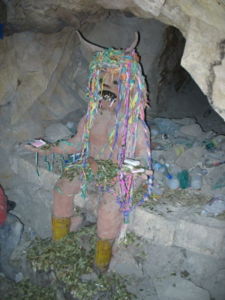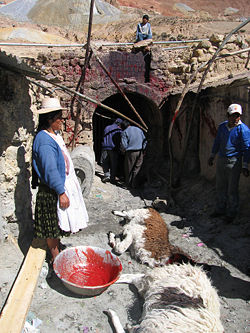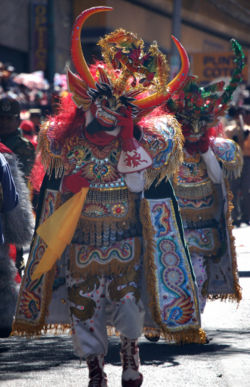El Tío
In the mines of highland Bolivia, "El Tío" is the familiar name for the spirit owner of the mountain, who is also known as Huari or Supay. The words "El Tío" are Spanish for "the uncle" and evince the relationship of patronage that the miners have with the spirit. He is associated with pre-Hispanic huacas as well as the Christian Devil and is a central figure in the ritual life of Bolivian mining communities. An icon of the Tío is situated in each mineshaft to receive sacrificial offerings of alcohol, coca, cigarettes, llama blood and other ritual items from the miners in return for his goodwill and his guarantee of good health and good fortune in the mines.
The Images

One of many images of the Tío in the Cerro Rico mine in Potosi. See the gallery for more examples.
The Tío may take several different forms, including the specter of a bearded blond man resembling mine administrators or a succubus,[1] but he most often appears inside the mines in his physical form as a clay figure resembling popular notions of the Christian Devil. Typically, an image of the Tío is to be found seated in each active mineshaft in a niche near the miners' work area.
The figures vary widely in their size and composition. Some, like the image from the Cerro Rico mine now on display in the museum there, are elaborately sculpted and decorated and may be as large as a human. Most images are smaller and less gaudy, but still easily identifiable due to the conspicuous horns that grow from the Tío's head. His eyes may be made of discarded light bulbs from the miners' helmets or pieces of metal ore and his teeth are often formed of shards of glass or crystal. Images of the Tío embody his greed and insatiability – his mouth is open to accept cigarettes and coca, his hand is outstretched for offerings of alcohol, his erect phallus betrays his voracity. Surrounding the images are streamers or bits of confetti from past rites and the remnants of the offerings that the miners have made to satiate the Tío's voracious appetite.
The Ch'alla and the K'araku
Two types of offering are made to the Tío: the ch'alla and the k'araku.
The most notable ch'allas are performed on the Tuesday of Carnival and during the month of August but miners also make a small ch'alla to the Tío each Tuesday and Friday when they enter the mine to work. The image is draped with streamers and a cigarette is placed in his mouth. Then the miners sprinkle him with liquor, offer him coca leaves and light his cigarette. They sit with the image and share his indulgence, drinking, smoking and chewing coca.
The k'araku is performed by a yatiri (shaman) following the ch'alla to the Tío during Carnival and to placate him after an accident in the mines. It is often observed with horror by outsiders because it involves the ritual sacrifice of one or more llamas. The llamas are sacrificed at the entrance of the mine and their blood is collected in a large bowl. The blood is splashed across the entrance to the mine and splattered on machinery within the mine or on the rock faces of active veins. In many cases, the llama's heart or a dried llama fetus purchased for the occasion is buried at the image's feet. The miners must then leave the mine so that the Tío can enjoy his meal uninterrupted while they feast on llama meat on the surface.
These rites of sacrifice to the spirit owner of the mines reflect both the pre-Columbian system of reciprocity and the relations of patronage that have come down from Spanish colonial society. In the pre-Columbian Andean world view, the huacas that were embodied in natural landmarks were an important part of the social landscape. They were tied into the social fabric through the same sort of relationships of ritual exchange and reciprocity that bound together the ayllu. The Inca state was held together through a system of ritual gift giving in which leaders showed their generosity and held the loyalty of their subjects by reciprocating the gifts that communities conveyed to them.[2] In the same way, health and good fortune were guaranteed for the community by entering into ritual relationships of sacrifice with the spirits – caring for the spirits ensured that the spirits would care for them.
The Tío is not characterized by generosity, however. He is distinguished by his insatiable appetite. The miners must always think of that appetite and sacrifice llamas so that he will not claim human lives instead. His demands are more akin to those that indigenous men faced under the colonial order in which they were forced into the mines under the mita system and held to impossible production quotas.[2] To escape such a fate, members of the lower classes were obliged to seek the favor of a patron, a powerful ally who would intervene on their behalf. Such interventions were obtained through bribes in much the same way that miners petition the favor of the Tío.
The Tío's Domain
As the lord of the hills, the Tío's domain is entirely underground. The surface belongs to God. Consequently, the Tío never appears in church and it is taboo to make mention of God or the saints inside the mines, lest the Tío withhold his riches. Even the pickaxe, which has the shape of the cross, is avoided as much as possible within the mines.[3]
In the past, the images of the Tío were carried out of the mines following the ch'alla to him during Carnival, but today he leaves the mine only in the form of costumed dancers of the Diablada, a dance performed during Carnival in honor of the Virgin of the Mineshaft. The exact origins of this dance are unknown but it is thought to have been first performed in Oruro, the folkloric capital of Bolivia.[4] The dance tells three stories, including the legend of Huari quoted below, the appearance of the Virgin of the Mineshaft to the thief Chiruchiru, and the Archangel Michael's triumph over the seven deadly sins. Devil characters wear ornate costumes adorned with symbols from the Huari myth including frogs, lizards and snakes in the belief that "if they wear devil costumes during Carnival, [the Tío] will identify and sympathize with them, and will bring them wealth and good luck in the coming year."[4] The devils are joined in their dramatic performance by other dancers masquerading as China Supay (the devil's consort), angels, bears, and female devils.
The presence of the devil dancers in a tradition meant to honor the Virgin is explained by the distinction that Cynthia Lecount points out between the devil that lives in the mines, presiding over the wealth that they contain, and the Devil that lives in Hell and presides over the souls of sinners.[4] In fact, the Tío is called "the Devil" primarily for the benefit of outsiders – initially Catholic priests and subsequently tourists who are alien to the indigenous cosmogony. The Aymaras regard the two types of devil as entirely separate entities. What is more, the dancers remove their masks before entering the chapel upon the conclusion of the dance. Thus, there is no contradiction.
Scholars have used the physical and temporal separation of the realms inhabited by the Christian and Andean deities to suggest that the religion of Andean highland culture is not as syncretic as it appears on the surface.[5][4] Despite many loans between the two traditions, the Aymaras understand the ritual activities that are associated with the Andean spirits and those associated with the Catholic saints as manifestly different. They maintain the two different, sometimes conflicting sets of beliefs and are largely able to do so because those beliefs are carefully separated so that they never actually come into direct conflict.
History
In agricultural communities, devotions to the pre-Columbian nature spirits remain an important part of ritual life, but the spirit of the hills has risen to a conspicuous position in the devotional lives of the mining communities of the region. Like the other spirits, Supay was originally a highly ambivalent entity, capable of bringing good as well as bad fortune. Sacrificial offerings to him ensured his good disposition and helped to maintain equilibrium in the forces that governed his domain. With the increased disturbance of those forces caused by mining activities, the spirit of the hills began to change in nature, becoming more malevolent in character and more vengeful in his actions. One myth from Oruro, translated by June Nash from Beltrán Herédia, sets the stage for this transition:[5]
The community of Uru Uru [pre-Hispanic name for Oruro] was one of fishermen and pastoralists devoted to the worship of the Sun. Every day Huari [the spirit of the hills] was awakened by the first-born daughter of the Sun, Ñusta. He fell in love with her and pursued her with arms of smoke and volcanic fire. The father came to her aid and hid her in the caves. Huari swore that he would bring vengeance against the town by turning it against the true religion. He became the apostle of a new religion and preached against Pachamac and his religious and social work. He thundered against Inti, the Sun God, and the old social hierarchy. He exalted in the superiority of material goods over spiritual, and of the labor of the mines over that of the field. The Urus resisted, but when Huari showed them gold and silver, they rebelled against their old beliefs and sacred authorities. Desirous of riches, they abandoned the daily hard but healthy work in their fields. They stopped praying to Inti and turned to wild drinking and midnight revels with chichi, a liquor unknown before then. In their drunken state there came forth serpents, toads, lizards, and ants who, in the acts of the witches' Sabbath, overwhelmed them. The inhabitants of the neighboring towns and even their friends and parents appropriated their goods. The people, abject with vice, were transformed into apathetic, silent and loveless beings.
The town would have disappeared because of internal fights had not Ñusta appeared on a rainbow one day after a heavy storm. Accompanying her were the chiefs and priests who had been exiled from the town when the people were perverted from their old ways. Little by little, men returned to what had been. They revived their traditions, customs, religion, and social order. They imposed Quechua on the Uru dialect. The fields would have recovered and even surpassed their fertility if Huari, in vengeance, had not sent four plagues on the repentant town: a serpent, a toad, a lizard, and ants. The monstrous serpent moved from the mountains of the south and devoured their fields and flocks. The Urus saw him and fled in terror, when suddenly someone shouted for Ñusta, and the monster was divided in two by a sword. The other three plagues, advancing from the other compass points, were also killed by the intervention of Ñusta, who overwhelmed the vengeful Huari. Today a chapel stands on the hill where the giant lizard was killed. It is said that the lake [near Cala Cala] still turns red at dawn from the blood of the lizard that flowed into it. The ants were turned into sand dunes that can still be seen on the southern borders of the town. Peace returned to the town.
Though images of Supay were present in the mines prior to the arrival of the Spanish, mining activities under Inca rule were practiced on a small scale and did little to change the ritual relationships between the miners and the spirits: it was not until the intensification of mining under colonial rule that Huari's overtly evil temperament, so palpable in the myth quoted above, began to appear.[1] Colonial administrators instituted the mita system in 1605, requiring indigenous men to perform two to four months of forced labor in the mines or factories owned by Spanish colonials. The lord of the hills took on many of the characteristics that the miners must have perceived in the extortionate owners and administrators of the mines.
Huari's outward character was also influenced by religious ideology that the Iberian colonizers brought with them from Europe. Catholic priests regarded much of the indigenous religion as idolatry and were enthusiastic in their attempts to reshape indigenous beliefs by re-articulating native spirits as figures from the Christian pantheon. Within indigenous mining communities, Ñusta became the Virgin of the Mineshaft and the spirit of the hills became the Devil, his images reworked to satisfy the priests' descriptions.
Prior to the nationalization of the mines in 1952, miners were organized into work groups and paid according to the amount and quality of the ore that they were able to extract from the mine. These workgroups would perform the rites to the Tío as a way to reinforce group solidarity and to gain an edge over rival workgroups by winning the Tío's favor. Those who went into the mines alone were suspected of making deals with the Tío for their personal gain; it is said that those who sell their souls to the Tío for riches die within 30 days.
Following the nationalization of the mines and the military coup of 1965, the miners' relationship with the spirit of the hills changed again. Workers were paid standard wages rather than by their production rates so supplications to the Tío for increased productivity were no longer necessary. Such rites were also suppressed by the mining administrators, as were other indigenous rituals throughout the country. Despite these pressures, the ch'alla and the k'araku continued to be practiced clandestinely as a source of solidarity and cultural pride. Today, many miners continue to make small daily ritual sacrifices to the Tío in return for his protection in the mine while larger ceremonies are held following tragedies in the mines and on the appropriate days in the ritual calendar.
Sources
- ↑ 1.0 1.1 Michael T. Taussig. 1980. The Devil and Commodity fetishism in South America. ISBN 0-8078-4106-4
- ↑ 2.0 2.1 Steve J. Stern. 1993. Peru's Indian Peoples and the Challenges of Spanish Conquest. ISBN 0-299-14184-5
- ↑ June Nash. 1992. I Spent My Life in the Mines: The Story of Juan Rojas, Bolivian Tin Miner. ISBN 0-231-07937-0
- ↑ 4.0 4.1 4.2 4.3 Cynthia Lecount. 1999. Carnival in Bolivia: Devils dancing for the virgin. Western Folklore 58(3/4):231-252.
- ↑ 5.0 5.1 June Nash. 1993. We Eat the Mines and the Mines Eat Us: Dependency and Exploitation in Bolivian Tin Mines. ISBN 0-231-08051-4


